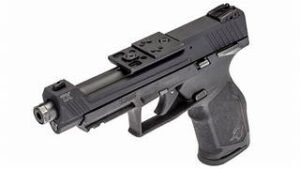Air pollution can significantly affect our health, oftentimes without us knowing. Finding the best air quality monitoring systems is critical to our survival. This equipment can detect pollutants in our air, helping us make informed decisions. So what are the best air quality monitoring systems?

Choosing the best air quality monitors for survival depends on several factors, including threats, resources, and technical skills. Here are seven options to consider, each with its strengths and weaknesses.
If you are unfamiliar with air quality monitoring systems, click here for our buyer’s guide.
The Best Air Quality Monitoring Systems
Best Overall
Key Features Pros Cons:
- Detects Radon, PM2.5, CO2, VOC, temperature, humidity
- WiFi connectivity with long life (up to 2 years)
- Can be integrated with smart home systems
- User-friendly app w/ smart home integration (IFTTT, Google, Amzn)
- More expensive, not as portable as other monitors
- Retail: $300
Best Budget
Key Features:
- Tracks PM2.5, temperature, and humidity
- Affordable, easy to use, works with Alexa
- Does not detect as many pollutants as some other monitors
- No long-term air quality data
- Retail: $70
Best Compact
Key Features:
- PM2.5 sensor, temperature and humidity sensor, Bluetooth connectivity, small and portable
- Affordable, small and portable, easy to use
- Does not detect as many pollutants as some other monitors
- No WiFi connectivity and no long-term air quality data
Best Splurge
Key Features:
- An affordable option that tracks PM2.5, temperature, and humidity. It’s a good choice for those who want a basic air quality monitor
- Affordable, easy to use, works with Alexa
- Does not detect as many pollutants as some other monitors
- No long-term air quality data
- Retail: $299
Best Portable
Key Features:
- PM2.5, PM10, temperature, and humidity sensors
- Bluetooth connectivity with built-in OLED display
- Long battery life, real-time air quality data on display
- Limited pollutant detection, no WiFi connectivity
- Basic App functionality
- Retail: $160
Best Outdoor
Key Features:
- PM2.5, PM10, temperature, and humidity sensors
- WiFi connectivity w/ large LCD
- Weather forecast updates, solar-powered option
- Durable and weatherproof for outdoor use
- Large display for easy readability
- Lacks VOC and other indoor pollutant detection
- No App for monitoring
- Retail: $179
Best Indoor
Key Features:
- PM2.5, PM10, temperature and humidity sensors
- USB powered w/ large LCD display
- Laser particle sensor for fast detection
- Limited pollutant detection, No WiFi connectivity
- Bulkier design compared to some others
- Retail: $90
Best Air Quality Monitoring Systems Buyer's Guide
Finding the best air quality monitoring systems is critical in our rapidly urbanizing and industrializing world. These systems track particulate matter, ozone, and nitrogen dioxide, offering insights into the air’s quality. This information guides pollution control and reduction efforts of individuals, communities, and governments.
Purpose and Benefits Overview
The best air quality monitoring systems serve two main purposes: measuring pollutants accurately and providing data for analysis. They help identify pollution sources, assess health risks, and ensure environmental regulation compliance. Benefits include:
- Personal Health: Knowledge of air quality enables individuals to avoid polluted areas.
- Public Health: Governments use data to shape pollution control policies.
- Environmental Protection: These systems assess the effectiveness of environmental initiatives.
- Industrial Compliance: Industries monitor emissions to stay within regulatory limits.
Best Air Quality Monitoring Systems Overview
The best air quality monitoring systems use advanced sensors to measure indoor and outdoor pollutants. They provide data for informed decision-making and protecting public health and the environment.
Air quality monitoring systems use sensors to collect data on particulate matter, ozone, and nitrogen dioxide. This continuous monitoring is crucial for understanding and mitigating the health effects of air pollution.
Types of Pollutants Monitored
- Outdoor Pollutants: Include particulate matter, ozone, and nitrogen dioxide from industrial emissions, vehicle exhausts, and natural sources.
- Indoor Pollutants: Emanate from cooking, cleaning products, and building materials. Key indoor pollutants include volatile organic compounds (VOCs) and carbon monoxide (CO).
Key Features
- Sensors and Detectors: Measure pollutants like particulate matter and gases.
- Data Collection and Analysis: Systems collect real-time data that is accessible via mobile apps or online platforms, enabling prompt and informed actions.
- Portability: This can be used for traveling in remote areas. Click for The Best Portable Air Filtration Systems.
- IoT Integration: Allows remote monitoring and control.
- AI Algorithms: Enhance accuracy and predictive capabilities, offering insights and proactive pollution management.
Accuracy and Precision of Measurements
Range of Pollutants Detected
Data Collection and Analysis Capabilities
Types of the Best Air Quality Monitoring Systems
Indoor air quality monitors
Outdoor air quality monitors
Fixed-location monitors for community-level monitoring.
Best Air Quality Monitoring Systems on the Market
Sensor-based systems
Frequently Asked Questions (FAQ)
Q1: What is the most accurate air quality monitor? A: The most accurate air quality monitor can vary depending on your needs and budget. Some highly accurate options include the Aeroqual Series 200, the IQAir AirVisual Pro, and the Aeroqual Series 300.
Q2: What is the best indoor air quality monitor? A: The best indoor air quality monitor depends on your preferences and requirements. Popular choices for indoor monitoring include the Dyson Pure Cool TP04, the Blueair Blue Pure 211+, and the Airthings Wave Plus.
Q3: What is the best way to monitor indoor air quality? A: The best way to monitor indoor air quality is to use a combination of sensors and devices that measure various pollutants, including PM2.5, VOCs, CO2, and humidity. Ensuring proper ventilation, using air purifiers, and reducing pollutant sources are essential for maintaining good indoor air quality.
Q4: What is the best air quality monitoring systems for home in 2024? A: Airthings Plus Radon & Air Quality Monitor. This monitor detects various pollutants, including radon, carbon dioxide, VOCs, PM2.5, and PM10. It also has a long battery life and a user-friendly app.
Conclusion – Best Air Quality Monitoring Systems
Air quality monitoring systems are vital for our health and the environment. They range from city-wide networks to personal devices, all enhanced by technologies like IoT and AI.
These systems inform us about air quality and encourage better air quality management. Embracing these innovations, we can work towards a cleaner, healthier world.










